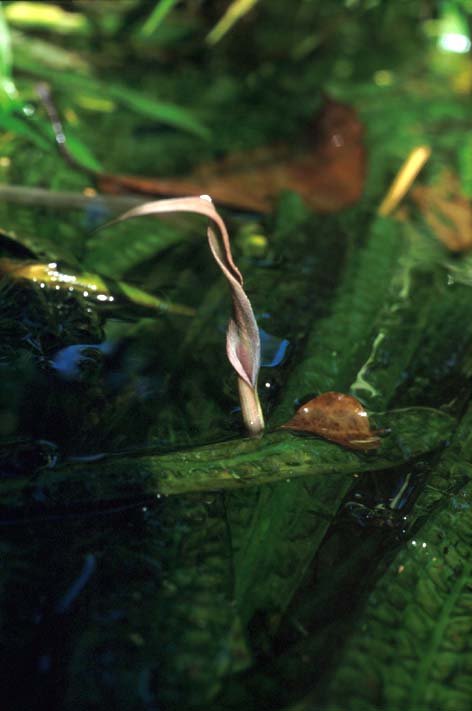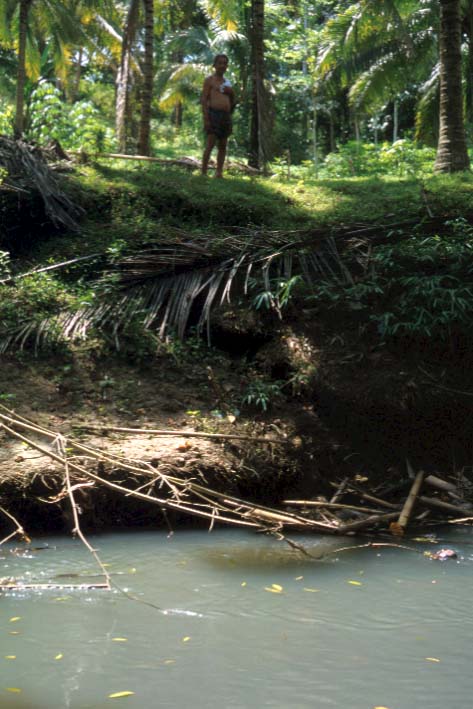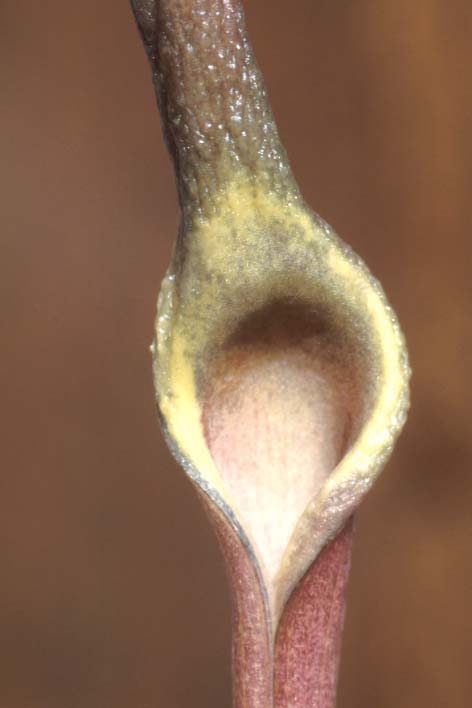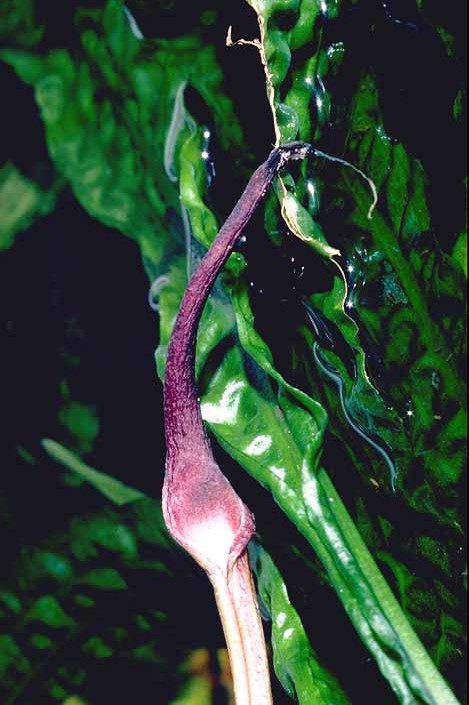 |
Cryptocoryne aponogetifolia growing in the Sorsogon
province, Luzon, Philippines.
photo Bogner |
|
 |
A creme colored spathe of C. aponogetifolia found in
the Sorsogon area.
|
|
 |
A small stream with an abundant growth of C.
aponogetifolia.It is easy to walk in this river. |
|
 |
Mr. Morco showing the giant plants of C. aponogetifolia found in the Sorsogon area.
|
|
| |
|
|
|
 |
The streams in Sorsogon are crystal clear, C.
aponogetifolia is the dominating aquatic plant.
|
|
 |
Lots of inflorescences were found in the month May. Note the
long peduncle of the spathe. Only the limb of the spathe points out of the water.
|
|
 |
This river in the Albay province (Luzon) was cloudy;
scattered along the river there were big stands of C. aponogetifolia.
|
|
 |
The water level is rather low but may rise in a short time
for more than a meter.
|
|
| |
|
|
|
 |
In the dry period, some banks are exposed. C.
aponogetifolia is growing emersed here. The small plants were deeply buried in the
gravel.
|
|
 |
A big patch of C. aponogetifolia extending for 100
m! Not easy to walk through for the water depth is c 1 m at the edge.
|
|
 |
The is much debris on the leaves, the water current is
apparently very slow between the leaves.
|
|
 |
We could not find any inflorescence in this river in the
Albay province, this big frog could not compensate for that.
|
|
| |
|
|
|
 |
An emersed cultivated specimen of C.
aponogetifolia from Sorsogon. As these plants arrived at Aqua Fleur nurseries in the
Netherlands, the rhizome was put in rockwool for cultivation.
|
|
 |
A close view on the throat of C.
aponogetifolia. The throat is purplish, surrounded by a broad yellowish rim. The
upper part of the limb is rounded back, probably because of too low humidity.
|
|
 |
It is no problem to cultivate C.
aponogetifolia emersed. This specimen was fully grown emersed, but on the long term
it was not a success.
|
|
 |
Cultivated in the 70's by A.J. Huurman, C.
aponogetifolia grows together with C. affinis in an old fishtank. The spathe
exceeds 50 cm. Moderate temperature, hard water.
|
|
| |
|
|
|
 |
The inflorescence of a cultivated C.
aponogetifolia. Note the limb of the spathe which has the edges turned back.
|
|
 |
Different spathe's of cultivated C.
aponogetifolia. Note the denticulate margin of the limb of the spathe.
photo Jacobsen
|
|
 |
The collar(zone) in this specimen is rather
pronounced.
photo Jacobsen
|
|
 |
A quite 'normal' limb of the spathe of C.
aponogetifolia.
photo Jacobsen
|
|
| |
|
|
|
 |
Opened kettle of a few days old inflorescence of C. aponogetifolia (the pollen is to be released). The naked part of the spadix is
more or less polygonal in cross section, not seen in other Cryptocoryne. |
|
 |
De Wit (1990) joined drawings of C.
aponogetifolia (the bullate, linear leafed plant at left) and C. usteriana (ovate leaves at right) together in one picture. Until 1983 (before the famous collection
of Bogner) most botanist believed both species were identical. De Wit doubted 30 years,
and it turned out he was alright.
drawing Ike Zewald
|
|
 |
The herbarium sheet of the Ramos and Edano
collection made in 1918 from the Panay island, Philippines. It is uncertain if C.
aponogetifolia still exists over there.
herbarium Singapore |
|
 |
Currently known distribution of C.
aponogetifolia in the Philippines. Historical records are from the isles Negros,
Panay and the south-east of Luzon. Recent collections are only known from the Sorgozon and
Albay provinces (Luzon).
|
|
| |
|
|
|
Cryptocoryne aponogetifolia is a very big plant. I saw specimens of over 1
meter tall in a public aquarium. The almost linear leaves are strongly bullate. The color
of the leaves is grass green and do not have any purple color on their sides. The
inflorescence can reach up to 50 cm and often has a strongly twisted tube. The limb of the
spathe can vary as seen above.
Updated December 2001 |
Literature.
- Bogner, J., 1984. Cryptocoryne usteriana Engler und Cryptocoryne
aponogetifolia Merrill. Aqua-Planta 4-84 : 7-13.
- Bogner, J., 1990. Filipino Cryptocoryne. Aquarist & Pondkeeper January 1990 : 38.
- Jacobsen, N., 1985. Cryptocoryne usteriana Engler. Aqua-Planta 4-85 : 14.
- Kasselmann, C., 1995. Aquarienpflanzen. Ulmer, Stuttgart.
- Merrill, E.D., 1919. Noteworthy Philippine Plants, XV. The Philippine Journal of Science
14 : 370-371.
- Merrill, E.D., 1925. Cryptocoryne, An Enumeration of Philippine Flowering Plants 1 : 189.
- Schulze, J., 1978. An den naturlichen Standorte von Cryptocoryne aponogetifolia Merrill in
den Philippinen. DATZ 31 : 310 - 314.
- Wit, H.C.D.de, 1990. Aquarienpflanzen, 2. Auflage. Ulmer, Stuttgart.
|
|